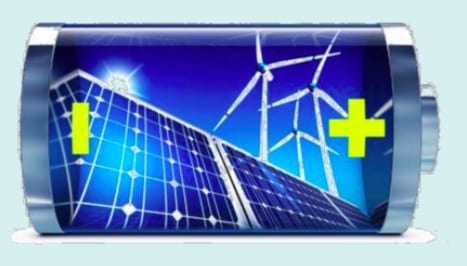Josh Frydenberg might have been right when he said that the Coalition’s proposed National Energy Guarantee would not stop investment in wind and solar:
It probably doesn’t matter how big a wall of policy and regulatory inertia is built, the plunging costs of renewables and rise of storage solutions and smart business models means it can’t actually be stopped.
Slowed, maybe. Stopped, no.
This past week has seen several landmark developments and announcements that signal that the pace of the energy transition is gathering speed, with huge implications across the board for consumers (mostly good) and incumbent utilities (mostly not so good).
First of all is the plunging cost of solar. In the corridors of the Energy Networks Australia conference in Sydney last week, the talk was of the cost of large-scale solar falling to the low $A40s/MWh, at least in the eyes of the banks who would finance it.
If that seems a little starry-eyed to some – because it is about 50 per cent below the assumed cost and less than half the price of grid power – then the prospect of some 30GW of excess solar module production over the rest of the year would seem to confirm it.
The bombshell delivered last week by Chinese authorities – thanks to an about-face on incentives for new generation (both renewables and fossil fuel, given that country’s over-supply – should make it obvious that more price falls are on the way.
Bloomberg New Energy Finance predicts that the cost in modules will plunge by one third – from just US37c/watt to US24c/watt, and the impact will be global. That should lead to price falls in Australia for a complete solar installation of at least 10 per cent – and balance of systems costs and financing costs are also falling.
Battery storage is the second part of the equation, because intense competition – and the growing understanding of its role in the market – is causing a massive re-think about both the cost of that storage, and its value. It is now both cheaper, and more valuable, than previously thought.
We are seeing that play out in the market place – with both Mars Australia and University of Queensland signing up for “firm solar” contracts for 100 per cent of their electricity needs that offers a significant discount to their current supply from the grid.
The biggest of them all, however, was from Gupta’s GFG Alliance, and its deal to deliver its own version of “firm solar” power to five big mining and industrial energy users in South Australia, and slash their electricity bills by up to 50 per cent along the way.
Let’s just contemplate the significance of these developments.
Effectively, what this means is that corporate Australia is now doing what households and smaller businesses have been doing for the past few years – and in increasingly greater numbers – turning to solar, and now storage, to slash their bills.
Gupta’s ambition is to boost this investment five-fold in South Australia – both for his own and for third party electricity needs, and then replicate this model around the other states, with an ambition for up to 10GW of large scale solar satisfying his expanding manufacturing business and others.
Those with the most to worry about this stunning development – and the emergence of what Gupta and UQ refer to as “gen-sumers” – are the big retailers, or “gen-tailers”, particularly those over-invested in base-load coal generation. This development represents a fundamental threat to the business model of the big incumbents.
The defection of household load has already caused serious issues for the big incumbents – and increasing concern about who gets to compete in a shrinking pie, as networks begin to shake their tree and wonder if there is a place for traditional gen-tailers in the future grid.
It was interesting to note Ausgrid CEO Richard Gross raising this issue at the Energy Networks Conference last week, just as Ron Stobbe from SA Power Networks did some years ago. The only thing that separates these businesses are “ring-fencing rules”, but networks are keen to break down the barriers.
Some big gen-tailers can see what’s happening. In others, there is a complete state of denial.
I talked last weekend to the former head of new generation for one gen-tailer, and was told that this utility did not want to offer solar and storage packages to existing customers, for fear of losing “volume”. It beggars belief. Kodak anyone?
The fact that the corporate sector is now defecting to new entrants that can offer, or broker, cheaper renewable energy supplies, with “firming”, means that they no longer have to go through a major retailer.
In a series of recent reports, Morgan Stanley analysts note the potential disruption. Big consumers can buy the output, and solar plant developers can land a contract, from and for large-scale solar with the need for an incumbent integrated utility, they note.
In effect, the drawbridge has been lowered, and the renewable energy hordes, and their storage Sherpas have broken through the defences so carefully erected by regulatory and policy fiat and market dominance over the past few decades.
Morgan Stanley says it sees disruption at every point in the value chain for incumbents like AGL, which with the largest, dirtiest and most inflexible of portfolios (coal), remains most exposed, but ironically most aware of their vulnerability. They could hardly get out of Liddell quickly enough.
The Morgan Stanley analysts say product innovation and price transparency may facilitate the disintermediation of incumbents, e.g., commercial and industrial (C&I) customers who are now able to procure renewables under contract and hedge the intermittency, without the need for an incumbent gentailer.
On the other hand, the disaggregation of intermittent and dispatchable power prices could help gentailers to better earn returns on dispatchable plant, without the need to write long-term contracts against renewables.
For instance, Origin may be able to generate a return on its gas-fired generation by selling firming products, while C&I customers write separate power purchase agreements (PPAs) to renewables developers, Morgan Stanley says.
But this pre-supposes that gas-fired generation can compete with other forms of storage, and the storage developers say they can’t.
Brian Perusse, a vice president with Fluence, the battery storage joint venture between global energy giant Siemens and storage specialist AES says gas cannot compete with solar and storage.
Fluence plans to build a series of “solar peaking” plants in Australia, that will compete head to head with gas peaking.
“This is the lowest cost source of energy,” Perusse tells RenewEconomy. “It is dispatchable, it is flexible, and it has no emissions.”
Peruse says solar prices are dropping under $A50/MWh, and batteries – at a cost of $A15-$A35/MWh – can provide three to four hours of storage. At those price, gas peaking plant cannot compete.
“No other resource can deliver that sort of pricing,” he says. (You can here his interview in our latest Energy Insiders podcast here).
And batteries, and other forms of storage, are going to be essential as more renewables enter the grid.
It is quite likely that prices in the middle of the day in Queensland could fall into negative territory as the amount of large scale solar expands exponentially, and rooftop solar continues to grow.
That will require flexibility and dispatchability. What will provide that? Well, Fluence says it knows what it won’t be: “My view is that you don’t build gas peakers. “
The corporate PPA market in Australia, like most things in the energy industry, is opaque, with only vague references given to the price of contracts.
That’s not the case in the US, and two deals in the last couple of days show the stunning fall in costs there. Berkshire Hathaway signing up for 1GW of wind and solar at an average price of US2.39c a kilowatt.
In Arizona, a new deal for a 30MW solar plant is priced at just US2.49c/kWh. The significance of that is increased by the fact that it will help replace a coal plant that was costing US5c/kWh. Solar came in at less than half the price.
Even more stunning is a deal by Warren Buffett’s Nevada Energy, the state utility, to buy more than 1GW of solar – some at prices as low as US2.15c/kWh, and rising with inflation (2.5 per cent). One 300MW solar plant agreed to sell its output at 2.37c/kWh – flat for 25 years.
That is an extraordinary low price. And ironically, it comes as the state market becomes open to competition, a shift triggered by the decision by major users MGM Resorts, Wynn Resorts, Walmart, Patagonia and Tesla to break their contracts and seek independent supplies.
As Mark Leslie, the head of Fluence in the Asia-Pacific, told the Smart Energy Conference, in Melbourne on Tuesday, what’s happening here in Australia is not foreign to what’s happening in other markets.
So, is it all an open house? Well, not so fast. Just as new wind and solar is being threatened by Donald Trump’s plans to subsidise coal and gas-fired power stations in the US, Frydenberg may also be able to slow the transition, even if he can’t stop it.
And that’s through the NEG, because without any effective emissions target – the 26 per cent reduction will already be largely met by 2020 – then there is no incentive for new generation on that front.
Tristan Edis, from Green Energy Markets, suggests that the corporate market could slow down considerably because of falling prices caused by the build out of renewables.
But that is where the likes of Gupta and others could become critical. Competition is king, and not having an ageing and increasingly expensive and unreliable fossil fuel fleet will be an advantage.
And the final gatekeeper? That would be Frydenberg and the federal Coalition. Given that the emissions target is met, and the price of solar, wind and storage is cheaper and better than anything that fossil fuels can provide, there is really no excuse for a lack of ambition.
For a start, it wouldn’t cost anything above BAU and would very likely be significantly cheaper. In an era when bills are soaring, and the evidence of climate change becomes more compelling, and disturbing, the case for trying to shut the door as the horse is bolting looks untenable.
Note: Please tune in to our latest Energy Insiders podcast to hear interviews with Fluence, Frydenberg, and ENA chief executive Andrew Dillon.












